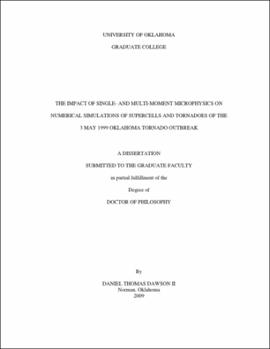| dc.contributor.advisor | Xue, Ming | |
| dc.creator | Dawson, Daniel Thomas | |
| dc.date.accessioned | 2019-04-27T21:35:14Z | |
| dc.date.available | 2019-04-27T21:35:14Z | |
| dc.date.issued | 2009 | |
| dc.identifier | 99314232302042 | |
| dc.identifier.uri | https://hdl.handle.net/11244/319072 | |
| dc.description.abstract | Accurate parameterization of cloud and precipitation microphysical processes is critically important in simulation and prediction of severe convective storms, including supercell storms and their associated circulations. The 3 May 1999 Oklahoma tornado outbreak was characterized by several discrete tornadic supercells in relatively close spatial and temporal proximity, which in general displayed relatively weak and small cold pools. In this work, a sophisticated multi-moment bulk microphysics parameterization scheme capable of predicting up to three moments of the drop or particle size distribution (PSD) for several liquid and ice hydrometeor species is evaluated and compared with traditional single-moment schemes through numerical simulations of the 3 May 1999 event. | |
| dc.description.abstract | First, idealized simulations of this outbreak are conducted at horizontal grid spacings from 1 km down to 250 m, using a sounding extracted from a real-data simulation at 3 km grid spacing. The impacts of microphysics on cold pool strength and structure and on the overall reflectivity structure of the simulated storms are analyzed. It is shown through microphysics budget and trajectory analyses within the low level downdraft regions that the multi-moment scheme has several important advantages which lead to a much more realistic weaker and smaller cold pool and better reflectivity structure particularly in the forward flank region of the simulated supercells. Specifically, the improved treatment of evaporation and melting processes and their effects on the predicted rain and hail PSDs by the multi-moment scheme helps to control the cold bias often found in simulations using typical single-moment schemes. The multi-moment results are more consistent with observed thermodynamic conditions within the cold pools of the discrete supercells of the 3 May 1999 outbreak. | |
| dc.description.abstract | Real-data simulations of this event down to 100 m horizontal resolution are performed, with an emphasis on the prediction of the Moore, Oklahoma F5 tornado produced by one of the supercells. The performance of the multi-moment microphysics scheme is tested and several issues are discussed in relation to the thermodynamic properties of the rear-flank downdrafts of the storms, which includes the tendency for the single-moment schemes to produce large temperature and moisture deficits in the rear-flank downdraft/hook echo region of the storm, as opposed to much smaller temperature and moisture deficits (and in some cases temperature excesses) seen in the multi-moment runs, which are much more consistent with mobile mesonet observations. The multi-moment simulations also in general produce a better prediction of the tornado track and intensity than the single-moment simulations; reasons for these differences are uncovered through analyses of the thermodynamic fields, terms in the vertical momentum equation and differences in the PSDs of rain and hail in the RFD/hook echo region of the simulated storms. The multi-moment simulations produce overall larger particle diameters for both rain and hail in the hook echo region, and have significantly less negative buoyancy in the near-tornado surface air, which is found to enhance tornadogenesis, whereas the strong negative buoyancy in the single-moment runs tends to suppress tornadogenesis. Finally, broader implications for numerical supercell tornado simulation and prediction are also discussed. | |
| dc.format.extent | 192 pages | |
| dc.format.medium | application.pdf | |
| dc.language | en_US | |
| dc.relation.requires | Adobe Acrobat Reader | |
| dc.subject | Tornadoes--Oklahoma | |
| dc.subject | Microphysics | |
| dc.subject | Precipitation (Meteorology)--Oklahoma | |
| dc.subject | Precipitation forecasting--Oklahoma | |
| dc.subject | Tornadoes--Forecasting--Oklahoma | |
| dc.title | THE IMPACT OF SINGLE- AND MULTI-MOMENT MICROPHYSICS ON NUMERICAL SIMULATIONS OF SUPERCELLS AND TORNADOES OF THE 3 MAY 1999 OKLAHOMA TORNADO OUTBREAK | |
| dc.type | text | |
| dc.type | document | |
| dc.thesis.degree | Ph.D. | |
| ou.group | College of Atmospheric & Geographic Sciences::School of Meteorology | |
